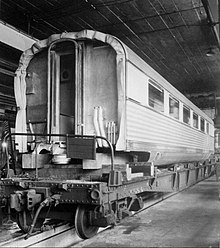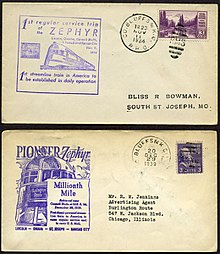Pioneer Zephyr
It was the first of nine similarly built trainsets made for Burlington and its technologies were pivotal in the subsequent dieselization of passenger rail service.
Its operating economy, speed, and public appeal demonstrated the potential for diesel-electric-powered trains to revitalize and restore profitability to passenger rail service that had suffered a catastrophic loss of business with the Great Depression.
It operated this and other routes until its retirement in 1960, when it was donated to Chicago's Museum of Science & Industry, where it remains on public display.
[15] Shotwelding, as Ragsdale termed his method,[16] involved automatic control of the timing of individual spot welds.
[21] Budd was familiar with the development of stationary diesel engines, and believed their superior reliability and fuel economy could be an asset for train transport as well.
[22] The exterior design of the train was left to aeronautical engineer Albert Gardner Dean (Walter Dean's younger brother) who designed the sloping nose shape, with architects Paul Philippe Cret and John Harbeson, devising a way to strengthen and beautify the sides with the train's horizontal fluting.
The story begins with pilgrims setting out on a journey, inspired by the budding springtime and by Zephyrus, the gentle and nurturing west wind.
[7][10] The first car, which measured 71 feet 5 inches (21.77 m), contained the cab, engine compartment and a mail storage area.
The main generator was mounted to the prime mover and sat between the engineer's and fireman's seats in the front of the power car.
[32] In early May 1934, the train was driven back westward over the Pennsylvania Railroad's mainline to Chicago, and some parallel routes, exceeding 100 miles per hour (160 km/h) several times.
It made additional promotional stops in other cities along the route, including Lincoln, Nebraska, where 21,000 people viewed the train.
[39] Stations along the route were protected by local police officers and members of the American Legion and the Boy Scouts of America.
The non-stop 1,015 mile (1,633 km) trip exceeded the railroad's expectations in being 1 hour 55 minutes faster than was scheduled.
Riding the train were Ralph Budd, Edward G. Budd, Harold L. Hamilton, president of the Electro-Motive Corporation, a number of reporters, some Burlington employees, members of the public,[41] and Zeph, a burro that was contributed by a Colorado newspaper, the Rocky Mountain News, as a mascot for the train.
[45] Part of this tour included a test run between Chicago and Minneapolis - Saint Paul,[46] completing the test trip in just over six hours,[47] besting the Burlington Route's fastest steam-powered service by five hours and convincing the railroad to promptly place orders with Budd and GM for two more Zephyr trainsets.
Some of their early reliability problems were mitigated with changes to individual parts such as pistons; other solutions had to wait for a differently designed engine.
The trainset replaced a pair of steam locomotives and six heavyweight passenger cars, weighing up to eight times as much as the Zephyr.
[4] The fourth car was originally a 40-seat coach number 525, but the following June it was switched to Twin Cities service, then back to the Pioneer Zephyr in December.
Just over five years after it was introduced, the Pioneer Zephyr crossed the one million mile mark in regular service on December 29, 1939, near Council Bluffs, Iowa.
Five mail clerks were injured and the engineer was killed, and the accident drove home the advantages for crew safety of the elevated, behind-the-nose cab design of the contemporary EMC E-series locomotives.
After the nine original Zephyr sets were completed during 1934–1939, standard production model diesel passenger locomotives with improved engines became available.
In 1948 and 1949, the Pioneer Zephyr was temporarily removed from service to participate in the Chicago Railroad Fair's "Wheels A-Rolling" pageant.
Government-formed Amtrak took over most passenger rail services in 1971, and finally succeeded in reviving the full California Zephyr in 1983.
The Pioneer Zephyr's famous Denver-Chicago dash served as the inspiration for the 1934 film The Silver Streak starring Charles Starrett.
[23][45] In that story, the crew was racing to the Boulder Dam construction site with an iron lung, with only moments to spare.
For the film, the "Burlington Route" nameplate on the train's nose was replaced with one that read "Silver Streak".
While a revolutionary design, the Pioneer Zephyr was not the first streamliner—that title went to the M-10000 of the Union Pacific Railroad, which made its first trip in February 1934.
[59] On May 26, 1960, the 26th anniversary of the "Dawn-to-Dusk" dash, the original Pioneer Zephyr train (car numbers 9900, 505 and 570) was donated to Chicago's Museum of Science & Industry (MSI).
The Pioneer Zephyr train is now on display at MSI just outside the main entrance from the museum's underground parking area, where it is one of the more popular exhibits.
There, powered by one of the large "E" series passenger diesels (an EMC E5) with the distinctive and durable stainless-steel fluting, it is still operated on short runs on the museum's substantial trackage, providing train enthusiasts and tourists with an experience reminiscent of the heyday of the Burlington's Zephyr service.










